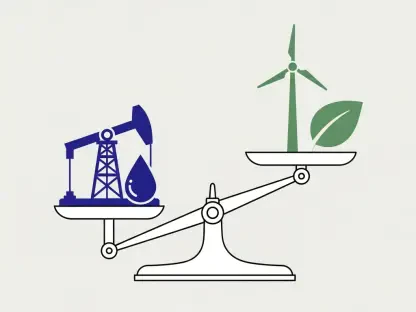Imagine a scenario where U.S. crude oil stockpiles drop by a staggering 6 million barrels in a single week, far surpassing expectations and sending ripples through global energy markets, while this sharp decline, reported for the week ending August 15, tightens supply conditions at a time when demand for oil and refined products appears robust. With exports soaring and imports dwindling, the oil landscape is shifting rapidly. This roundup gathers diverse perspectives from industry analysts, market watchers, and energy experts to unpack the driving forces behind this inventory plunge, explore varying opinions on its implications, and assess what it means for stakeholders navigating an ever-evolving market.
Unpacking the Inventory Decline: A Multi-Faceted View
The latest data from the U.S. Energy Information Administration (EIA) reveals that crude inventories fell to 420.7 million barrels, a drop that caught many by surprise as it exceeded forecasts by over threefold. Industry observers note that this significant drawdown signals a tightening of supply, raising questions about sustainability amid global energy needs. This section dives into a collection of insights to understand the broader context of this development.
Different sources highlight the interplay of international and domestic factors contributing to this shift. While some emphasize the bullish outlook for oil prices, others caution about potential supply chain strains. The consensus, however, points to a market at a critical juncture, with inventory levels serving as a key indicator of future price movements and energy security.
A variety of opinions also emerge on how this decline reshapes market sentiment. Some analysts view it as a temporary anomaly driven by seasonal patterns, while others see it as a structural change reflecting deeper shifts in trade dynamics. These contrasting takes set the stage for a deeper exploration of specific forces at play.
Key Drivers Behind the Stockpile Drop: Diverse Perspectives
Export Surge and Import Decline: A Tightening Balance
One of the most discussed factors is the dramatic rise in U.S. crude exports, up by 795,000 barrels per day (bpd) to 4.37 million bpd, coupled with a steep 1.22 million bpd fall in imports. Many industry voices consider this export boom a clear bullish signal, reflecting strong international demand for American crude. This viewpoint underscores the competitive edge of U.S. oil in global markets.
On the flip side, some market watchers express concern over the sharp drop in imports, warning that prolonged reductions could stress domestic supply chains. There’s a split in opinion on whether this trend is a short-term adjustment or a longer-term risk, with certain experts pointing to potential geopolitical barriers that might hinder export growth. This divergence highlights the complexity of balancing trade flows.
Additionally, a few sources suggest that the export-import imbalance might prompt strategic adjustments from producers and refiners. Discussions center on whether the U.S. can maintain this export momentum without compromising domestic needs, offering a nuanced take on how global trade dynamics influence local stockpiles.
Refinery Activity at Peak Levels: Strength or Strain?
Turning to domestic factors, refinery runs have increased by 28,000 bpd, with utilization rates hitting an impressive 96.6%, contributing significantly to the inventory drawdown. Many analysts applaud this high activity as a sign of robust demand for refined products, with implied oil consumption reaching 21.5 million bpd. This perspective paints a picture of a resilient refining sector.
However, not all opinions align on the sustainability of such high utilization. Some industry insiders caution that operating near full capacity leaves little room for unexpected disruptions, such as maintenance shutdowns or equipment failures. This concern introduces a layer of caution to the otherwise positive narrative surrounding refinery strength.
A third angle focuses on the broader implications of this trend for market stability. Certain voices suggest that while current demand supports high refinery output, any slowdown in consumption could quickly reverse the inventory decline. This diversity of thought reveals the delicate balance between production capacity and market needs.
Demand Trends in Fuel Segments: Mixed Signals
Demand recovery in specific fuel categories, such as jet fuel reaching its highest four-week average since 2019, has garnered significant attention. Many experts see this as a strong indicator of rebounding travel and economic activity, bolstered by a 2.7 million-barrel drop in gasoline stocks. This optimism points to a consumer-driven push in key sectors.
Contrasting with this, the 2.3 million-barrel build in distillate stockpiles raises eyebrows among some analysts, who interpret it as a potential pocket of oversupply. Opinions differ on whether this buildup might dampen the bullish momentum seen elsewhere, with a few suggesting it reflects uneven demand recovery across fuel types. This split underscores the complexity of market balance.
Further insights explore how these mixed demand signals could shape pricing strategies. While some sources predict sustained upward pressure on oil prices due to strong jet fuel and gasoline demand, others warn that distillate oversupply could temper gains. This range of views offers a comprehensive look at the multifaceted nature of demand dynamics.
Market Responses and Price Impacts: Bullish or Cautious?
Following the EIA data release, Brent crude futures rose to $66.37 per barrel and West Texas Intermediate (WTI) climbed to $62.83 per barrel, reflecting a positive market reaction. A significant portion of industry feedback labels this price uptick as evidence of strong fundamentals, with supply constraints driving investor confidence. This bullish sentiment dominates current discussions.
Yet, a smaller group of market observers notes minor counterpoints, such as a 419,000-barrel inventory increase at the Cushing hub, suggesting localized oversupply could offset broader gains. This differing perspective introduces a note of caution, with some questioning whether price increases are fully justified by the data. The contrast enriches the debate on market direction.
Additional commentary speculates on long-term price trajectories, with varying predictions on how sustained supply tightness might influence investment decisions. While many anticipate continued price support, a few argue that external factors like geopolitical tensions could disrupt this trend. These diverse outlooks provide a rounded view of financial implications.
Strategic Takeaways: Navigating the Oil Market Landscape
For industry stakeholders, the insights gathered point to several actionable strategies. Monitoring import trends remains crucial for supply planning, as prolonged declines could necessitate alternative sourcing. Simultaneously, leveraging export opportunities in a bullish market is widely recommended by experts as a way to capitalize on international demand.
Investors and policymakers also receive tailored advice from various sources. Tracking weekly EIA data releases for timely market decisions is a common tip, while assessing demand patterns across fuel segments allows for targeted investment or regulatory focus. These recommendations reflect a consensus on the importance of data-driven approaches.
Beyond immediate actions, some perspectives emphasize the need for long-term planning. Discussions around diversifying energy supply chains and preparing for potential demand shifts offer strategic depth, ensuring stakeholders are equipped to handle both current conditions and future uncertainties. This blend of short- and long-term advice rounds out the guidance.
Reflecting on the Roundup: Steps Forward
Looking back, this compilation of insights paints a vivid picture of a U.S. oil market grappling with a significant inventory decline, driven by export surges, import drops, and robust demand in key areas. The varied opinions from industry analysts and market observers provide a balanced view, highlighting both the bullish sentiment and underlying risks that shape market reactions.
Moving forward, stakeholders are encouraged to delve deeper into specific demand segments like jet fuel and gasoline for investment opportunities, while keeping a close eye on distillate stockpiles to mitigate risks of oversupply. Exploring international partnerships to stabilize import flows could also prove vital in maintaining supply chain resilience.
As the energy sector continues to evolve, adopting a proactive stance by integrating these diverse insights into decision-making processes stands out as a critical next step. Engaging with ongoing EIA reports and industry analyses will further equip players to navigate the complexities of tightening crude supplies and shifting market dynamics.









